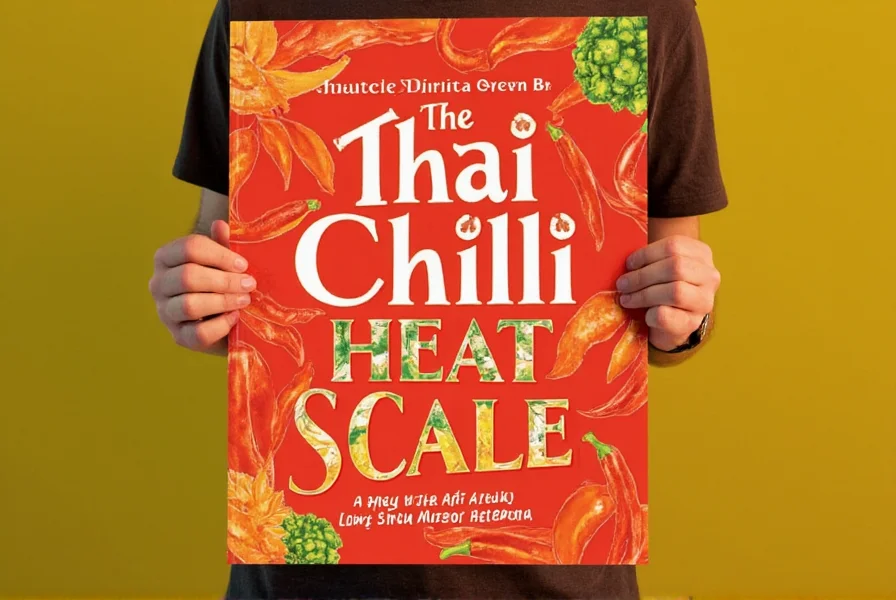Table of Contents
Introduction to the Thai Chilli Heat Scale
The Thai chilli heat scale measures spiciness from 1,000 to 100,000 Scoville Heat Units (SHU), with Bird's Eye Chili (Prik Kee Noo) being the hottest variety. This guide provides a clear breakdown of Thai chilli types, their heat levels, flavor profiles, and practical tips for authentic Thai cooking.
Understanding the Thai Chilli Heat Scale
The Thai chilli heat scale quantifies capsaicin concentration using Scoville Heat Units (SHU). It helps identify the intensity of different Thai chilli varieties, which is crucial for authentic Thai cooking. Here's a breakdown of common Thai chilli types:
| Chilli Type | Heat Level (SHU) | Flavor Profile |
|---|---|---|
| Bird's Eye Chili (Prik Kee Noo) | 50,000 - 100,000 | Sharp, citrusy, intensely spicy |
| Prik Chee Fah (Long Red Chili) | 10,000 - 30,000 | Mildly sweet, tangy, versatile |
| Prik Yuak (Mild Green Chili) | 1,000 - 5,000 | Fruity, mild, subtle heat |
These varieties represent authentic Thai chillies used in traditional cuisine. Note that jalapeños and sriracha are not Thai chillies; they originate from Mexico and are commonly confused with Thai varieties due to global usage.
Practical Tips for Handling Thai Chillis
Whether you're cooking at home or experimenting in a restaurant, handling Thai chillies requires specific knowledge. Here are essential tips:
- Wear gloves: Capsaicin binds to skin and causes irritation. Always wear gloves when cutting or handling fresh chillies.
- Use a sharp knife: A sharp knife reduces bruising, minimizing capsaicin release and heat intensity.
- Wash hands thoroughly: After handling chillies, wash with soap and water. Avoid touching eyes or face until hands are clean.
- Start small: Begin with minimal amounts and taste gradually. You can always add more heat, but removing excess is impossible.
- Use dairy to neutralize burn: Milk or yogurt proteins bind to capsaicin, providing immediate relief from spicy sensations.
Buying Guide: How to Choose the Right Thai Chilli
Selecting authentic Thai chillies depends on your recipe, spice tolerance, and culinary goals. Here's a detailed guide:
1. Bird's Eye Chili (Prik Kee Noo)
Features: Small, thin, bright red or green, extremely hot.
Advantages: Delivers intense heat with bright citrus notes, essential for authentic Thai curries and stir-fries.
Use Cases: Traditional Thai dishes like Tom Yum soup, green curry, and spicy salads.
Target Audience: Experienced cooks and spice enthusiasts seeking authentic flavor profiles.
Suitable Occasions: Special occasion cooking, Thai restaurant recipes, or when maximum heat is required.
2. Prik Chee Fah (Long Red Chili)
Features: Longer and thicker than Bird's Eye, typically red when mature.
Advantages: Balanced heat with sweet undertones, ideal for sauces and marinades without overwhelming dishes.
Use Cases: Thai dipping sauces, stir-fried vegetables, and noodle dishes.
Target Audience: Home cooks and intermediate spice lovers.
Suitable Occasions: Weeknight dinners, family meals, and everyday cooking.
3. Prik Yuak (Mild Green Chili)
Features: Small, green, and smooth-skinned, often used fresh in salads.
Advantages: Mild heat with fruity notes, perfect for adding subtle spice without overpowering delicate flavors.
Use Cases: Thai salads (Yam), fresh spring rolls, and garnishes for seafood dishes.
Target Audience: Beginners and those sensitive to spice.
Suitable Occasions: Light meals, breakfast dishes, and children's recipes.
Conclusion
The Thai chilli heat scale is a vital tool for authentic Thai cuisine. By understanding SHU ranges and flavor profiles of Bird's Eye, Prik Chee Fah, and Prik Yuak, you can confidently select the right chilli for any dish. Remember: Thai chillies are defined by their unique regional characteristics, not by global substitutes like jalapeños. Mastering this scale transforms your cooking from generic "spicy" to truly authentic Thai flavor.
Frequently Asked Questions (FAQ)
- Q: What is the Thai chilli heat scale?
A: The Thai chilli heat scale measures spiciness using Scoville Heat Units (SHU), quantifying capsaicin concentration across authentic Thai chilli varieties from mild (1,000 SHU) to extremely hot (100,000 SHU). - Q: How hot are Thai bird's eye chillies compared to jalapeños?
A: Thai bird's eye chillies (50,000-100,000 SHU) are 6-40 times hotter than jalapeños (2,500-8,000 SHU), but note jalapeños are Mexican, not Thai. True Thai chillies like Prik Chee Fah (10,000-30,000 SHU) are closer in heat to jalapeños. - Q: Can I reduce the heat of Thai chillies without losing flavor?
A: Yes—remove seeds and white membranes (where capsaicin concentrates) while keeping the flesh. This preserves citrusy or fruity notes while reducing heat intensity. - Q: Which Thai chilli is best for beginners?
A: Prik Yuak (1,000-5,000 SHU) offers mild, fruity heat ideal for newcomers. Prik Chee Fah (10,000-30,000 SHU) is a good intermediate option for those building tolerance. - Q: Why do Thai recipes specify chilli types instead of just "spicy"?
A: Thai cuisine relies on distinct flavor profiles: Bird's Eye adds sharp citrus fire, Prik Chee Fah provides sweet-tangy balance, and Prik Yuak contributes subtle fruitiness. Substituting alters the dish's authenticity. - Q: How should I store fresh Thai chillies?
A: Keep unwashed chillies in a paper bag in the refrigerator crisper drawer for 2-3 weeks. For long-term storage, freeze whole chillies in an airtight container for up to 6 months.











 浙公网安备
33010002000092号
浙公网安备
33010002000092号 浙B2-20120091-4
浙B2-20120091-4